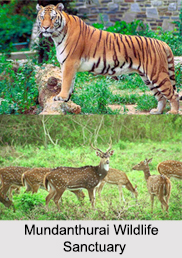 Tourism in Tirunelveli boasts some impeccable Hindu temples, wildlife sanctuaries and waterfalls as attractions and pilgrimage destinations. Tirunelveli City is situated on the banks of the River Thamirabarani in Tamil Nadu. There are several picturesque visiting places in and around Tirunelveli City, which attract lots of tourists. Some of them are given here:
Tourism in Tirunelveli boasts some impeccable Hindu temples, wildlife sanctuaries and waterfalls as attractions and pilgrimage destinations. Tirunelveli City is situated on the banks of the River Thamirabarani in Tamil Nadu. There are several picturesque visiting places in and around Tirunelveli City, which attract lots of tourists. Some of them are given here:
Krishnapuram Temple: The Krishnapuram temple is situated about 13 kms from Tirunelveli city of Tamil Nadu. It is dedicated to Lord Vishnu, which is an important tourist destination. This temple is an important part of art and architecture of Tamil Nadu.
Courtallam Waterfalls: The Courtallam waterfall is situated 59 kms from Tirunelveli. It is called the "Spa of the South" and it is located at an elevation of 170 metres, on the Western Ghats. This is also a health resort apart from being a tourist spot of Tamil Nadu.
Sankaran Koil Temple: It is situated 56 kms north of Tirunelveli. This temple is a representation of fusion of two faiths; Shaivism and Vaishnavism as it contains an image combining both the aspects. All the symbols of Shiva, deer, cobra, moon, etc can be seen bearing on the right half and the left half has all the symbols of Vishnu like Chakra, conch etc. The `Prakarams` of the temple are adorned with many excellent paintings.
 Tenkasi: Tenkasi means "Dakshina Kashi", the Varanasi of the south. This temple is dedicated to Viswanatha. The Pandya king Paranthaga Pandiyan after returning from the Benaras constructed this temple. It is situated 53 kms from Tirunelveli and 7 kms from Courtallam.
Tenkasi: Tenkasi means "Dakshina Kashi", the Varanasi of the south. This temple is dedicated to Viswanatha. The Pandya king Paranthaga Pandiyan after returning from the Benaras constructed this temple. It is situated 53 kms from Tirunelveli and 7 kms from Courtallam.
Thirumalaiappan Pozhil: This is a beautiful temple dedicated to Lord Muruga atop of a hill rock. It is 15 kms from Courtallam.
Kazhugumalai Temple: Kazhugumalai temple is situated 76 kms from Tirunelveli. Here, the shrine is created from a huge rock. The unique feature of this temple is that rather than rising from the foundations, it was chiselled from the top.
Thirumalaipuram: This place is situated 16 kms from Tenkasi. A rock-cut temple here with Ganesha, Vishnu and dancing Shiva can be seen here.
Kalakadu Wildlife Sanctuary: It is situated 47 kms from Tirunelveli. The flora and fauna of this sanctuary are very famous. Tiger, panther, jackal, wild dogs, cobra, python and several snakes and other reptiles, the lion-tailed monkey, etc can be seen.
Shengaltheri: It is situated in the Kalakadu mountain area. It is 68 kms from Tirunelveli. It is in the area of Kalakadu wildlife sanctuary. It is renowned for its natural scenery and healthy climate, which makes it a perfect picnic spot. A perennial waterfall also can be seen here.




















